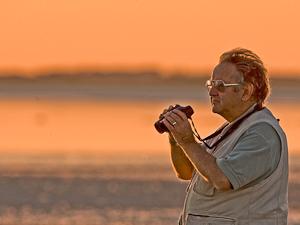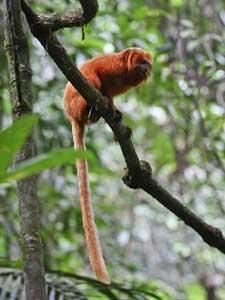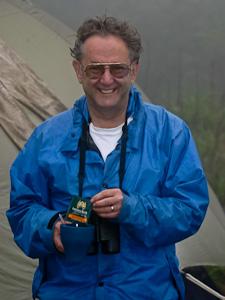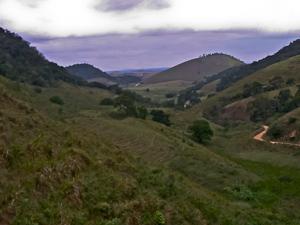

Dr. Pimm is the Doris Duke Chair of Conservation Ecology at the Nicholas School of the Environment and Earth Sciences at Duke University. He has authored four books and more than 150 scientific papers. He is one of the most-cited scientists in the world and a member of the American Academy of Arts and Sciences. An expert on biodiversity and extinction, he has conducted research in Brazil, the Everglades, Hawaii and Madagascar, among other locations. He leads The Pimm Group, "an informal collective of students past and present, colleagues and technicians associated with Dr. Stuart Pimm at Duke University in North Carolina." The Pimm Group's research interests include ornithology, climate change, natural disaster impacts, conservation, and more. He is the recipient of a Pew Scholarship for Conservation and the Environment (1993) and an Aldo Leopold Leadership Fellowship (1999) and has testified before the U.S. Congress regarding the re-authorization of the Endangered Species Act.
I had met Dr. Stuart Pimm three years earlier as a high school student visiting Duke. National Geographic Explorer and conservation biologist Dr. Luke Dollar, one of Dr. Pimm's former graduate students, introduced us. I worked as a volunteer on Luke's conservation and research project in Madagascar, which collects data on and protects the fossa, Madagascar's top endemic carnivore. Essential partners include the indigenous Malagasy people; one of the project's goals was to involve local residents in conservation and improve the lives of Malagasy people by supporting the local community.
Once Dr. Pimm arrived, we exchanged a warm and friendly greeting. His cheerful and relaxed demeanor immediately assuaged my jitters of excitement, and my nervousness about speaking with such an established member of the field of conservation biology soon subsided. After brief small talk, I opened up my laptop, clicked the red record button and began our interview.
Can you explain a bit more about "science with a sense of responsibility?"
Years ago, I was working in Hawaii. I had gone out there to do a basic science project. I had gone out there with my field guide expecting to see a long list of birds. I keep a birds list like many people do, and many of the species weren't there. I was working six days out of every eight in the field; I expected to see everything that was there, and I didn't. I realized that many of those species had become desperately rare. Many of [them], in fact, were already extinct. And that led me to believe that being a scientist doing science is not enough; that we have a responsibility to use our science to tackle important issues. That was well before we had a name for the field of conservation biology.
I had been quite successful by then as a pure scientist. I had published papers in Nature and Science. But I thought, you know, a generation from now, which is about now, what will people think of me if all I've done is pure science? It isn't enough to just do clever science when there are these massive issues of extinction, global warming, deforestation and ocean acidification, and all these other things. So I feel that scientists have a particularly crucial role in tackling those issues. I think what I'm known for is injecting science into this process of protecting biodiversity.
How do you think that humans' perceptions of their roles in the ecosystem affect species loss?
I think there are a lot of different attitudes. Certainly, people are part of nature. There are very few parts of the world where you can really get away from people. Interestingly, those are the kinds of places that I thought I would work in as an ecologist. I wanted to go to the places that were pristine, beautiful, and remote and study nature the way nature should be. I thought very consciously that I would never go to Hawaii because it was a place that was so badly beaten up. By one of those sort of wonderful accidents that make you believe that there are fairy godmothers who tap you on the shoulder and change your life, I ended up in Hawaii and realized that studying extinction, a very unnatural process, was going to be vitally important.
So yes, I believe that we are part of nature and there's no point in really trying to go to these places where we are not. But equally, we are not part of nature in the magnitude of the impacts that we have. I've been asked in this town in Congressional hearings, "Haven't species been going extinct in the past?" And the answer is: yes. "But you know, Senator, it's like death and taxes. You don't want either of them to be too high." It's the same with the extinction rate. Extinction rates are running one hundred to 1,000 times their natural rate, and that's not natural. Human beings live in nature but on the other hand, human beings, seven billion of us, pushing eight, pushing nine billion, are having impacts way beyond what is natural.
You've been on the ground in many places from the Everglades, to Madagascar, to Brazil. How have you tailored your plan of action to the particular place you are working? 
I thought, OK, suppose we take the Americas, where should we do conservation? We mapped out very simply where the greatest number of threatened birds were in all of the Americas. Birds because we knew we have good data on birds. We didn't have anywhere near such good data on mammals or amphibians, and that quickly told us that the greatest number of species threatened with extinction in all of the Americas is in the biodiversity hotspot that we call the coastal forest of Brazil, the Mata Atlantica. It's one of Brazil's two rainforests. Brazil has the Mato Grosso, the big forest, and the Atlantic forest, the Mata Atlantica.
I quite literally got on the plane and went and visited people who had never met me before... And I said, you know, we want to work with you guys and there was a look of great surprise and horror and they have now been our friends and colleagues for almost twenty years. What we then decided was OK, this is a big area. It's the size of California, Oregon and Washington – about a million square kilometers. So where in that area is the greatest number of species? We quickly found out that was the state of Rio de Janeiro, and then we began to look at patterns of extinction, patterns of threat, and we quickly began to model where species should occur. We worked out that the greatest number of threatened species were in isolated fragments of lowland forest in this area within the state of Rio de Janeiro.
Now, in addition to doing this very, very practical stuff, my group likes to study. One of our four programs is to study the science of endangerment, risk, and the processes that go on. And we know from work that we've done in Manaus, Tom Lovejoy's project, the biological dynamics of forest fragmentation. We know that if you have forest fragments, species within those fragments will go extinct because they are isolated. For all sorts of reasons, they have trouble finding mates, for example, in small populations. So when we saw these areas of isolated forest containing the greatest number of threatened species in all of the Americas, we thought, "What can we do?" And the obvious solution is to un-isolate them, to reconnect them. And one area in particular, a nature reserve called Uniao, was a big block of forest, and it was isolated from forest everywhere else... by a strip of cattle pasture maybe a hundred meters wide. And we looked at that and thought, "It has to go." And so we asked what it would take to buy that land. And the answer was: a third of a million dollars.
I founded a small, microscopic NGO called Saving Species, and we decided that what we were going to do was to raise money from people who are committing carbon sin. You know, we Americans put out seven tons of carbon into the atmosphere per year through fossil fuel consumption. So I thought, I will go around and I will sell indulgences to carbon sinners. So I will say, "You are a sinner, young lady! And for a mere seventy bucks a year, I can offset your carbon sin and you can help me buy bits of land and we will reforest that land. And we will save biodiversity in the process. It's very, very beautiful carbon." In the first year, I raised $300 and I felt very, very stupid. And the next year we raised a third of a million dollars. One of the things that I really dislike is the fact that this city we are sitting in, Washington, D.C., we are surrounded by an alphabet soup of NGOs, all of whom are raising money, most of whom are spending most of that money here in Washington, DC.
So we're Saving Species, the group of us, and the group is me; it's Peter Raven; it's Tom Lovejoy; it's Pat Wright; it's Norman Meyers. We decided we would be an all-volunteer organization, and we would have no staff. We would do all the work ourselves, but every single cent would go to land purchases. So when you and the readers of your magazine send in their fifty or seventy bucks every cent of that goes to land purchase. We raised the money and gave the money directly to a Brazilian NGO.... We gringos did not buy the land and that's very important. The NGO was not an NGO that worked on birds. It's an NGO that works on the golden lion tamarin, which is this very charismatic and very beautiful little monkey. It was isolated in that forest fragment, too. And the Golden Lion Tamarin Association, (Associação Mico-Leão Dourado) , was just thrilled.... We gave them the money and they bought the land. They immediately turned over the land to the Brazilian park service, which is called Instituto Chico Mendes, and so for the last three or four years this forest has been growing back. You can see the forest regrowth on Google Earth, so the people who gave us that money can see the carbon being soaked up out of the atmosphere. If you give that money to many of these other carbon offsetting scenes, you don't know where that money is going. If you give that money to us, it's very beautiful carbon. You can go to Google Earth and you can see it.
What happened then was the Brazilian park service said, well, we own this piece of land. We own now, thanks to Saving Species, the connection between this piece of land and this other piece of forest, and what we want to do now is to help redesign this entire area, an area of eight thousand hectares (eighty square kilometers) and make this a national park. That's in the process of happening.
I'm very proud of that story. I'm proud of it for good reasons, but it came from a very rigorous application of science. You focus in on where the greatest numbers of species are going extinct and you go to the place. You learn the natural history, you learn the biology, you learn the politics and the economics, and you learn what you can do. In this case it was very obvious: it was restore land.
I'm not a restoration ecologist. I didn't know anything about restoration, and I still don't know very much. But... it was clear to me that in this case the best we could was to join these forest fragments. That's the sort of process that I like. Not everything we do is that model. What we're doing in Africa, what we're doing in other places is different, but the whole point is you need to be driven by the problem. The problem is that we're losing species one hundred to 1,000 times faster than we should, and [we] ask exactly where that's happening and then stand back and say, what are the solutions?
Too many people are hammers that go around looking for nails. We look at the problem and decide what we need to do about it. We generally don't have the necessary skill or the background to do it. I don't have any skill in development. I didn't know how to raise money. The first year I made a complete mess of it. But I kept on until we raised enough money and had enough smarts that we realized we had to do this through the Brazilian organizations themselves. That's obviously an example of which I'm very proud, but it's an example of what we do to prevent the loss of biodiversity.

You cannot do it any other way. What happens in Brazil is entirely up to the Brazilians. It's their country. It's not ours. Soon after we made this purchase, I was at a meeting in Brazil, someone in the audience got up and said, "Why are you Americans buying up Brazil? This is our country. You ought not to be telling us what to do." And I knew that one day I would get that question. And I was able to say, Associação Mico-Leão Dourado is a Brazilian organization. They bought the land. Instituto Chico Mendes is your park service. They manage the land. You can't have a problem with that. And if I choose to help my Brazilian friends, you can't have a problem with that either.... But we had recognized that from the start. If we had gone in and said, "We're a bunch of smart gringos and we're going to show you "dumb savages" how to do things," we would have been in great trouble. So when you go to this project in Brazil, there's a nice big poster there that says something like Projecto Conectivo, it doesn't have my name on it. It doesn't have my organization's name on it. And I'm happy with that. This is not about my ego. It's not about a bunch of gringos trying to tell the "dumb" Brazilians what to do. It's about the Brazilians doing what they need to do to protect their own biodiversity. And I think that's really important, and it's what we do and [what] some of the other organizations on this side and the other side of the river do not do. You work with the local people. We did this through a Brazilian organization.
Now the stuff we do in Madagascar, we have to do it through villages, through very poor people. Now have you worked with Luke Dollar? Have you been out to Madagascar?
Yes, I have.
So you know the kinds of things he's doing there. It's not an accident that Luke does things like that. He wouldn't have been part of my group if he did it any other way. So the story of the restaurant and how that came about was entirely because of this philosophy of empowering local communities... it was fantastically successful.
The same organization that has done so poorly working in the coastal forests of Brazil was the same organization that squandered millions of dollars at that site [in Madagascar] and achieved nothing... because the last thing they wanted to work with was the local community. Luke, as you know, he goes into that local community, he loves the people there, he cares for the people there, their well-being matters, and that's how you achieve success.
So why should someone, like a businessperson in the U.S., for example, care about biodiversity in Brazil?
For me, that's really an ethical question. It's also an economic question. Let me answer the economic question first.
The government of Norway has committed a billion dollars to help Brazil slow its deforestation rate, and Brazil has. Brazil was the third largest emitter of greenhouse gases. So by reducing its deforestation rate, this billion dollars from Norway, which is one hundred times more per person than the U.S. has committed to provide and hasn't actually yet provided, helps to reduce global carbon emissions 15 percent. Fifteen percent of all carbon emissions come from deforestation. It's more than all the European Union put together.
Now why does that matter? If you live in a coastal community – and I live in Key Largo for half the year – the economic costs of global warming are enormous. I pay a prodigious amount of money for property insurance because the insurance companies understand global warming. It's a risk, and they understand it very well. They realize that a bad hurricane season – and bad hurricane seasons are more likely now than in the past – could have a spectacularly devastating effect on their industry. So there are simple economic reasons for us to slow deforestation. And deforestation is the principal driver of species loss. (It's) that simple.
But I think beyond economics, and the economic arguments are very powerful; it's just a simple, for me, religious, ethical issue. As a Christian, I believe we have a responsibility, a stewardship. You know the Bible says, "God so loved the Earth that He gave his only son." [...] and for me that's a very powerful, spiritual requirement that says we'd better be good stewards. Not everybody is as religious as I am, but I think many people also feel that we have an ethical responsibility to look after nature and that we have a responsibility to future generations. I want you, I want my daughters, I want my new grandson, to have the same beautiful planet that I've enjoyed.
So for me, yes, the economic reasons are powerful, and we better understand those economic issues. But we also better understand that there is a massive ethical issue with destroying the planet so that we don't hand to future generations a place that doesn't have rainforests, a planet that's many degrees hotter than this one, a planet where sea level rise has actually flooded some countries out of existence. I find those prospects to be evil. I believe people who do that are sinning and so for me, it's not just mere economics. There's a spiritual dimension to this, too.

I think one of the very encouraging things is when I first started [in] conservation, there was a real battle...There were two kinds of arguments. One of them was, well, ecologists do ecology and if you're not very smart you do conservation, that conservationists are the intellectually challenged. Well, if you've read my Balance of Nature, you'll know that the kinds of stuff I do is seriously rich, intellectually.
So I went around saying, look, no, the problems of predicting extinction risk, the problems of looking at how to reassemble communities, the problems of being able to understand how changing communities affect other species, these are really tough challenges. They require difficult mathematics. They are conceptually hard. And so conservation is not for the intellectually challenged.
And then there was a bunch of ecologists who said, well, I'm an ecologist and therefore I do conservation. My response to that was even ruder. The reality is that much of ecology doesn't have much impact. We have to address the questions that really matter. I think by and large we have won those two.
The difficult challenge is [finding] tools that we need. Most of what happens in a university setting is you come into the university and we say, oh, you need this tool and that tool and that tool. And we give you those tools, and you go away and use them. It doesn't work like that in conservation. I don't know what the appropriate toolkit is. I'm pretty sure there are certain kinds of tools, but I'm constantly being challenged to think of others. I think that's very exciting. It means conservation is a mission-driven science. But it also means it's hard to know how much economics you need, how much understanding of social issues you need. We're still trying to work out the limits of our field. I mean, you can pick up any textbook in chemistry, you can pick up any textbook in ecology, and have a pretty good sense of the kinds of topics that will be in there. I'm not sure what would be in a textbook of conservation....
We're going to solve problems by getting the kind of practical experience that you [Julia Osterman] have had. You go out to Madagascar, you see a problem, what skills you need to fix it, and I think that's what makes conservation exciting. It also makes it very fluid. We don't know what the techniques are. Should you know how to build mathematical models? Well, maybe. Should you know to engage people? Almost certainly. I mean there's a whole list of things that you need to know. We'll get there.
You know, twenty-five years from now, there will probably be conservation textbooks and they'll probably have a standard set of subjects in them. But I look at those textbooks, and I've written chapters in many of them and I think, well, my chapter's OK, but should we have had this chapter? And shouldn't we have had that chapter that's not there?
I think the challenge over the next decade is to learn what works and what doesn't. And even at a smaller scale. You know, Luke and I are doing all this work on big cats at the moment. We have about half dozen, maybe ten kinds of intervention to prevent cats from being killed; which ones work? Which ones don't work? And I don't have an answer to that. I hope in five years' time I will. But learning to say, what are the things we can do? What are the things that work? What are the things that don't work? That's the challenge.
I sometimes feel overwhelmed by all the issues plaguing our world today like biodiversity loss, poverty, global warming, etc. What keeps that from bogging you down, and what keeps you optimistic?
Can I solve all the world's problems? No. Can I solve all those problems locally? Almost certainly yes. Maybe I can solve some of those problems on a much larger scale than that. And it's not that I don't see bad things happening in the world; you better believe I do. But what keeps me enthusiastic is the successes that we have.
You know, when Luke started working at Ankarafantsika [National Park in Madagascar], none of the local kids were in school. There wasn't a school. So he builds a restaurant, and it's served some enormous number of meals. I like to tell people it's the finest restaurant in eighty kilometers. As you know, it's the only restaurant within eighty kilometers. [Now,] those kids are in school. More power to Luke. I mean, I think the world of Luke, precisely because he's made something work. Has he changed the lives of those people? You bet. Has he changed their attitudes towards that national park? Yes. Is that national park important nationally? Yes. Is it important internationally? Yes. So that's what keeps me excited. I fly over Madagascar, and I see the place going up in smoke. It breaks my heart. But I'm also encouraged by what we can do.